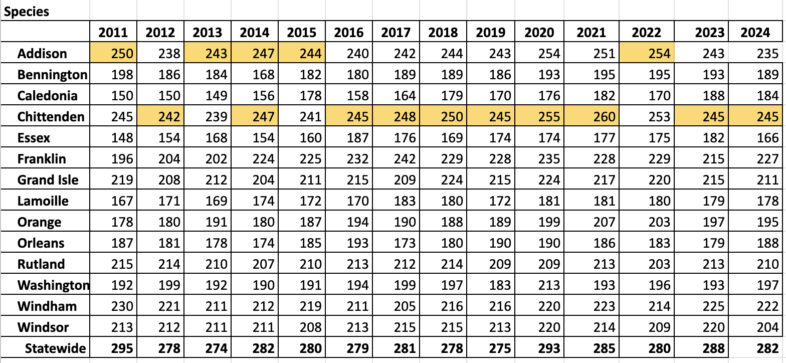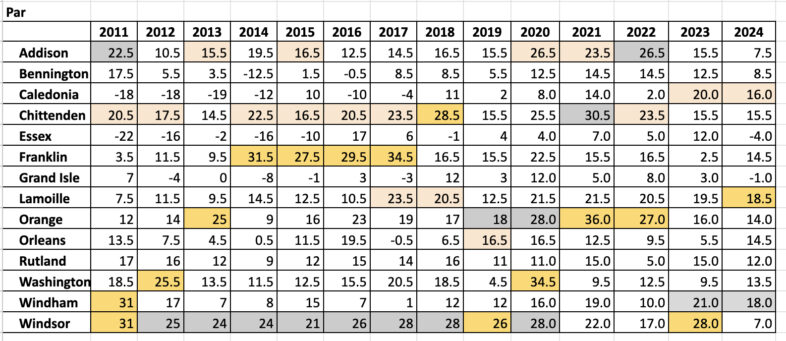From the Northeast Kingdom to the Massachusetts border, and from the Connecticut River to the waters of Lake Champlain, Vermont’s teaming birding community once again took part in the Vermont eBird County Quest in 2024. Marking the 14th year, this event continued to bolster Vermont’s enormous database of bird sightings, all in the spirit of friendly competition.
The annual year-long contest pits county versus county, birder against birder, all engaged in a friendly rivalry for top birding honors. The main idea behind the County Quest is simply to get people out birding, promote camaraderie, and better document bird life across the state using Vermont eBird.
Lamoille County won the gold medal for this first time in 2024, documenting 178 species of birds and giving them 18.5 birds over par and the victory. Windham County wasn’t far behind taking the silver medal with just a half-bird separating them from gold. With 16 birds above par, Caledonia County birders had another great year with a repeat bronze medal. Over the 14 years of the County Quest, Windsor County (home for the Vermont Center for Ecostudies), garnered the most metals with 11. Chittenden County with its bountiful bird life and bird watchers was not far behind with nine metals.
The County winners are based on a carefully calculated “par” system, recognizing that not all Vermont counties are created equal in terms of avian diversity. Par scores reflect the number of species that a given county should find in a year with consistent birding effort. Each year a particular county wins, five birds are added to their par.
Even with a par system, it was difficult to make it perfectly fair and even, so each year we also recognized the counties with the highest number of species documented–the raw count. As expected, the two counties with the most bird life, and the most birders, annually fought for gold. In 2024, Chittenden crushed the competition with 245 birds for a second year in a row. The county won gold in 10 of the 14 years of the Quest and holds the annual record with 260 birds in 2021.
Individual County Winners
These titles are awarded to the birders with the most checklists and bird species for each county. No par or weighting necessary for this one! Visit the Vermont eBird Top 100 list to get a full tally of Checklist and Species Champions for any year. Simply select the county and year you are interested in and see where you ranked, too!
One of the most popular awards among birders is the County 150 Club. Vermont eBirders who identified 150 species or more in a county during a calendar year are inducted into the prestigious 150 Club. Even in counties with higher avian diversity, a birder must be dedicated and in the field during all four seasons to join this club. Seven Vermont eBirders added their names to the honor roll in 2024. Check out the 150 Club list to see how you and your birding friends have done.
Finish one or go for all 14 counties! The 14th Star Award is an elite prize for those that have achieved 150 species in all 14 counties in Vermont, the 14th state. Only two Vermont birders have achieved this feat, Pat Pratt in 2019 and Craig Provost in 2020.
The Vermont 250 Club requires even more dedication. This is a list of eBirders who’ve found 250 or more bird species in Vermont during one calendar year. To complete this, birders have to find about 90% of the species found in Vermont in any given year. Only 17 birders have been added to this honor roll. Jim Mead has passed 250 species 13 times and the only one to do it in 2024.
eBird Vermont Celebrates 21st Year
2024 also marked the 21st year for eBird Vermont, the first state or provincial portal for the now worldwide, crowd-sourced database of bird records called eBird. Bird watchers have shared an astounding number of checklists, making eBird Vermont. a project of the Vermont Atlas of Life, the largest community science biodiversity project ever assembled in the state.
Since 2003, more than 17,575 Vermont eBirders have submitted over 9 million bird records from across the state. Those records represent nearly 772,000 complete bird checklists (counts of all birds found at a location at a given time), representing all 393 species of birds recorded in the state! Birders have added over 221,000 images, nearly 21,000 sound recordings, and 339 videos to Vermont checklists, creating an incredible open access resource for all.
It isn’t just about Vermont. More than 1.5 billion bird sightings have now been entered into eBird worldwide. eBird records now make up more than half of all all biodiversity data in the Global Biodiversity Information Facility (GBIF).
eBird is for Science and Conservation
And, of course, eBird isn’t all just for fun. It’s for science and conservation, too. eBird Vermont helps in delivering a new era of scientific and conservation applications, innovative new birding tools, and much more. As always, all of this is 100% free of charge to anyone who wishes to use it.
With eBird’s continued growth and the constant supply of valuable bird observations flowing in, the eBird status and trends project has continued to expand, now providing status and trends for 370 species known to occur in Vermont. These maps are interactive, and eBirders can now zoom and pan across a species’ entire global range or zoom into regions of Vermont. These maps are built from data submitted by eBirders, and provide immensely useful information about where bird populations are booming or declining.

This map depicts the cumulative change in estimated relative abundance for Bicknell’s Thrush from 2007 through 2021 with circles representing 27km x 27km regions. Red indicates decline and blue indicates increase. The darker the color, the stronger the trend. White circles represent locations where the trend estimate is not significantly different from zero (i.e., the 80% confidence interval contains zero). Circle sizes are scaled by the estimated relative abundance at the middle of the time period.
A new and exciting GIS mapping tool from the Northeast Habitat Conservation Initiative uses eBird Status & Trends breeding season data for 43 species of conservation priority across the eastern United States to inform conservation and land management efforts.

Map of the northeastern US depicting the number of forest-associated bird species of conservation importance estimated to have high-quality habitat within a 2.7 km (1.6 mi) square pixel. Colors range from blue (indicating no forest species of conservation priority have high-quality habitat in that pixel) to red (all 7 forest bird species of conservation importance have high-quality habitat within that pixel).
Thank You to All our Volunteers, Collaborators and Sponsors!
Congratulations to everyone for a fun year of birding! We hope some of you will vie for the County 150 Club or other top honors in 2025. You can follow the scoreboard all year long and see where you rank. Even if you come up short, all of the data collected in eBird Vermont is incredibly valuable for science, education, and conservation. Best of luck eBirding!
We’d like to thank the volunteer data experts that help us keep eBird Vermont data strong. Every record entered into eBird Vermont is checked for accuracy, first by automated filters that flag unusual records, and then by expert reviewers who devote their personal time to ensure that your lists and the eBird database are as accurate as possible.
- Cat Abbott – Windham County
- Tom Berriman – Essex County
- Zac Cota – Lamoille County, Washington County, Franklin County, Grand Isle County
- Jacob Crawford – Chittenden County
- Sue Elliott – Rutland County
- Kyle Jones – Bennington County and Orange County
- Richard Littauer – Addison County
- Coleen Lawlor – Bennington and Windsor Counties
- Jeff MacQueen – Caledonia County
- Kent McFarland – Vermont manager
- Chris Rimmer – Windsor County
- Bob Stymeist – Orleans County
- Chad Witko – Windham County
- Spencer Hardy (2010-2020) – Windsor and Windham Counties
- Nathaniel Sharp (2020-2022) – Windsor and Windham Counties
- Craig Provost (2010-2022) – Northeast Kingdom counties
- Ian Worley (2010-2023) – Lake Champlain counties
Additionally, Ron Payne, and Kent McFarland are Vermont hotspot editors.
If you run into any of these dedicated volunteers while out birding, let them know you are thankful for their hard work and contribution behind the scenes at eBird Vermont. And finally, thank you to all of eBird Vermont collaborators and sponsors that help make eBird Vermont an amazing project.


